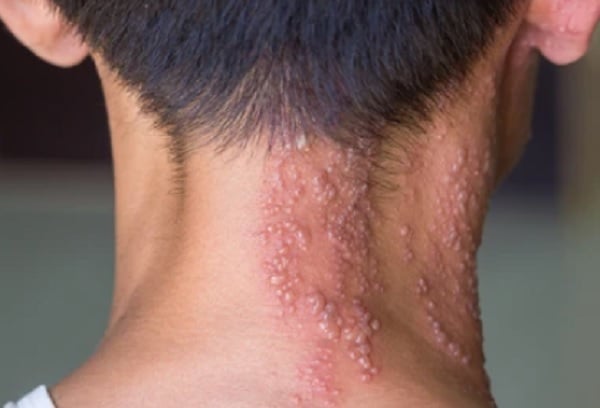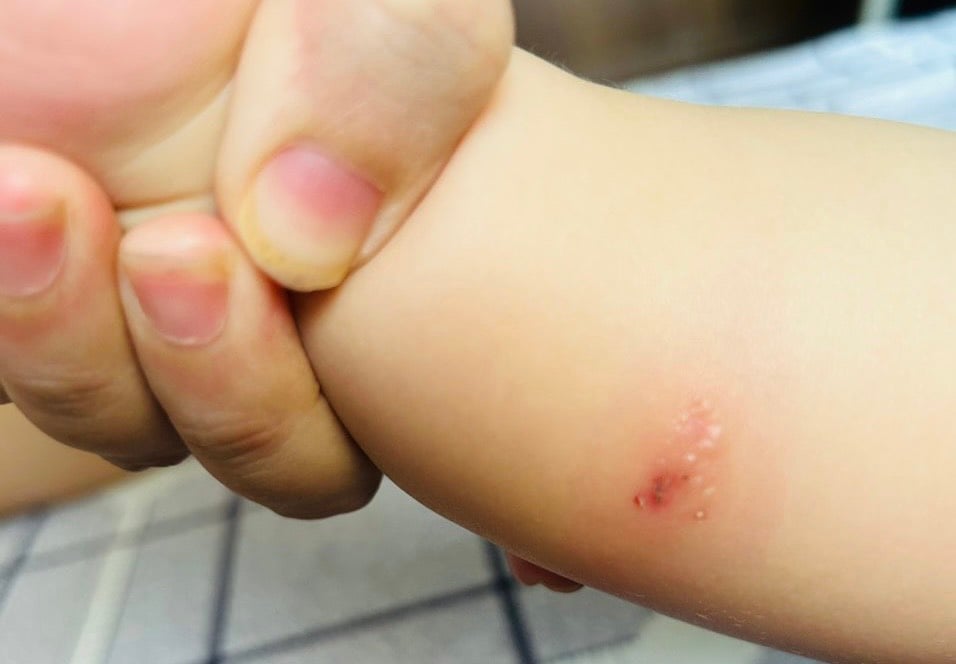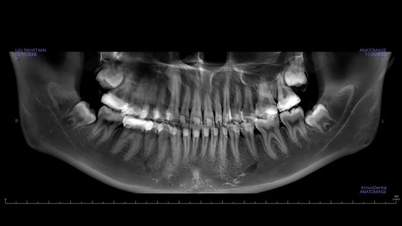On November 28th, Dr. Thai Thanh Yen (Department of Dermatology and Cosmetic Dermatology, University Medical Center of Ho Chi Minh City) stated that shingles is a skin infection caused by the Varicella-Zoster virus (VZV) , a member of the herpes virus family. After a person recovers from chickenpox, some Varicella viruses remain in a latent state but do not cause disease. These viruses reside in nerve ganglia for months or years. When favorable conditions arise, such as weakened immunity, mental trauma, or physical weakness, these viruses reactivate. They multiply and spread along sensory nerve endings, damaging the mucous membranes and skin, thus causing shingles.

In patients with shingles, vesicles appear in clusters, patches, or groups on a background of erythema A.
Confusion between shingles and dermatitis caused by blister beetles.
"The manifestations of skin infections caused by shingles and dermatitis caused by blister beetles are very similar, such as blisters on an erythematous background, and burning pain in the affected area. This makes it easy for many patients to confuse them in diagnosis and treatment, causing the patient's condition not only to not improve but also to progress to many serious complications, prolonging the recovery time," shared Dr. Thanh Yen.
In daily life, many people who suffer from contact dermatitis caused by blister beetles mistakenly think they have shingles and use Acyclovir to treat it. This can not only prevent the wounds from healing but also increase the risk of ulceration, infection, and secondary infections . However, these are actually two completely different skin infections in terms of their causes, clinical symptoms, and transmissibility.

Contact dermatitis blisters caused by blister beetles are usually small, red, and pustular.
Distinguishing between shingles and contact dermatitis caused by blister beetles is crucial for providing the correct and effective treatment and care, preventing the risk of complications and serious infections.
Here are some differences to distinguish between shingles and contact dermatitis caused by blister beetles:
Shingles | Contact dermatitis caused by blister beetles. | |
Reason | - Due to the activation of the Varicella-Zoster virus (VZV) in patients with a history of chickenpox and weakened immune systems. - Not related to weather or season | - This is due to the body coming into contact with the Pederin-containing secretion released by the rove beetle. - The disease is more common during the rainy season. |
Symptom | - Clusters of blisters, patches, or clusters on an erythematous background, following the pathways of sensory nerves attacked by the virus. - It mainly appears on one side of the body along the branch of the innervating nerve. - Sensation: Deep, burning pain extending to the nerve branches. | - The blisters are usually small, red, and pustular, tending to form long, whitish streaks/lines. - Causes burning sensation, mild swelling, and minimal itching. - There is no distinct distribution pattern; it usually follows the contact of the toxin. |
Risk of recurrence and complications | - Often leaves scars (keloid/atrophic scars) - Post-infection nerve pain can persist for months or even years. - Recurrence is rare; the recurrence rate of shingles in men and women after 8 years is 4% and 7%, respectively. | -It usually only leaves behind mild dry, scaly skin or post-inflammatory hyperpigmentation patches, which gradually improve over time. - It can recur whenever the body is re-exposed to the toxic secretions. |
Transmissibility | People with shingles can transmit VZV to others through direct contact with the blisters and rash on the affected skin area, causing chickenpox if the contact has never had chickenpox. If the contact has previously had chickenpox, there is a potential risk of developing shingles. | It is not contagious from person to person, but it can spread throughout the body if the wound is not properly cared for. |
Time to recover | After about 2 to 3 weeks. | After about 5-7 days. |
Source link



![[Photo] Prime Minister Pham Minh Chinh holds a phone call with the CEO of Russia's Rosatom Corporation.](/_next/image?url=https%3A%2F%2Fvphoto.vietnam.vn%2Fthumb%2F1200x675%2Fvietnam%2Fresource%2FIMAGE%2F2025%2F12%2F11%2F1765464552365_dsc-5295-jpg.webp&w=3840&q=75)



![[Photo] Closing Ceremony of the 10th Session of the 15th National Assembly](/_next/image?url=https%3A%2F%2Fvphoto.vietnam.vn%2Fthumb%2F1200x675%2Fvietnam%2Fresource%2FIMAGE%2F2025%2F12%2F11%2F1765448959967_image-1437-jpg.webp&w=3840&q=75)
















































![[OFFICIAL] MISA GROUP ANNOUNCES ITS PIONEERING BRAND POSITIONING IN BUILDING AGENTIC AI FOR BUSINESSES, HOUSEHOLDS, AND THE GOVERNMENT](https://vphoto.vietnam.vn/thumb/402x226/vietnam/resource/IMAGE/2025/12/11/1765444754256_agentic-ai_postfb-scaled.png)



















































Comment (0)